Water of crystallisation Study guides, Revision notes & Summaries
Looking for the best study guides, study notes and summaries about Water of crystallisation? On this page you'll find 68 study documents about Water of crystallisation.
All 68 results
Sort by
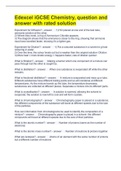
-
Edexcel iGCSE Chemistry, question and answer with rated solution
- Exam (elaborations) • 29 pages • 2023
- Available in package deal
-
- £16.59
- 1x sold
- + learn more
Edexcel iGCSE Chemistry, question and answer with rated solution Experiment for Diffusion? 1) HCl placed at one end of the test tube, ammonia solution at the other. 2) Where they meet, a ring of Ammonium Chloride appears. 3) The diagram shows that the ammonia is closer to the ring, showing that ammonia must have travelled faster, showing it's a lighter gas. Experiment for Dilution? 1) Put a coloured substance in a solvent e.g food colouring in water. 2) Over the time, the colour le...
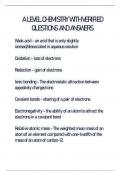
-
A LEVEL CHEMISTRY WITH VERIFIED QUESTIONS AND ANSWERS Weak acid - an acid that is only slightly ionised/dissociated in aqueous solution Oxidation - loss of electrons Reduction - gain of electrons Ionic bonding - The electrostatic attraction between op
- Exam (elaborations) • 9 pages • 2024
-
- £16.18
- + learn more
A LEVEL CHEMISTRY WITH VERIFIED QUESTIONS AND ANSWERS Weak acid - an acid that is only slightly ionised/dissociated in aqueous solution Oxidation - loss of electrons Reduction - gain of electrons Ionic bonding - The electrostatic attraction between oppositely charged ions Covalent bonds - sharing of a pair of electrons Electronegativity - the ability of an atom to attract the electrons in a covalent bond Relative atomic mass - The weighted mean mass of an atom of an element ...

-
AQA GCSE Questions & Correct Answers/ Graded A+
- Exam (elaborations) • 6 pages • 2024
-
- £8.25
- + learn more
Describe the plum pudding model of the atom : A ball of positive charge with randomly embedded negatively charged electrons in it. Atom contains electrons, protons and neutrons. Write the three particles in order : ron n on Predict outer shells of tennessine : Number of outer shells: 7 Reason: it is in group 7 Why tennessine was not accepted as a new element by other scientists until 2015 : Time needed for peer review 2 Plan a method to obtain pure dry crystals of zinc chloride from ...
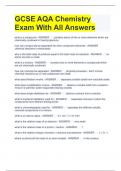
-
GCSE AQA Chemistry Exam With All Answers
- Exam (elaborations) • 55 pages • 2023
- Available in package deal
-
- £11.57
- + learn more
GCSE AQA Chemistry Exam With All Answers what is a compound - ANSWER contains atoms of two or more elements which are chemically combined in fixed proportions how can compounds be separated into their component elements - ANSWER chemical reactions or electrolysis why is the total mass of products equal to the total mass of reactants - ANSWER no atoms are lost or made what is a mixture - ANSWER contains two or more elements or compounds which are not chemically...
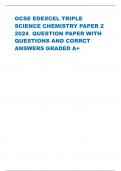
-
GCSE EDEXCEL TRIPLE SCIENCE CHEMISTRY PAPER 2 2024 QUESTION PAPER WITH QUESTIONS AND CORRCT ANSWERS GRADED A+
- Exam (elaborations) • 43 pages • 2024
-
- £11.33
- + learn more
GCSE EDEXCEL TRIPLE SCIENCE CHEMISTRY PAPER 2 2024 QUESTION PAPER WITH QUESTIONS AND CORRCT ANSWERS GRADED A+ What is in the nucleus? - CORRECT ANSWER-Protons and neutrons What is relative atomic mass? - CORRECT ANSWER-Relative atomic mass is an average mass taking into account the different masses and abundances of all the isotopes that make up the element How do you calculate the relative atomic mass? - CORRECT ANSWER-Sum of (isotope abundance x isotope mass number) / sum of abundances of a...
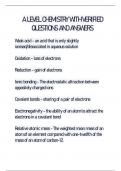
-
A LEVEL CHEMISTRY WITH VERIFIED QUESTIONS AND ANSWERS Weak acid - an acid that is only slightly ionised/dissociated in aqueous solution Oxidation - loss of electrons Reduction - gain of electrons Ionic bonding - The electrostatic attraction between op
- Exam (elaborations) • 9 pages • 2024
-
- £16.59
- + learn more
A LEVEL CHEMISTRY WITH VERIFIED QUESTIONS AND ANSWERS Weak acid - an acid that is only slightly ionised/dissociated in aqueous solution Oxidation - loss of electrons Reduction - gain of electrons Ionic bonding - The electrostatic attraction between oppositely charged ions Covalent bonds - sharing of a pair of electrons Electronegativity - the ability of an atom to attract the electrons in a covalent bond Relative atomic mass - The weighted mean mass of an atom of an element ...
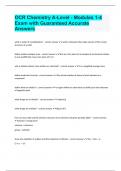
-
OCR Chemistry A-Level - Modules 1-4 Exam with Guaranteed Accurate Answers
- Exam (elaborations) • 10 pages • 2024
-
- £9.30
- + learn more
what is water of crystallisation? - correct answer water molecules that make up part of the crystal structure of a solid define relative isotopic mass - correct answer the ass of an atom of an isotope of an element relative to one twelfth the mass of an atom of C-12 why is relative atomic mass written as a decimal? - correct answer it is a weighted average mass define molecular formula - correct answer the actual number of atoms of each element in a compound define what an orbital is...
![AQA GCSE CHEMISTRY 8462/1F Paper 1 Foundation Tier Question Paper + Mark scheme [MERGED] June 2022 *Jun2284621F01* IB/M/Jun22/E10 8462/1F For Examiner’s Use Question Mark 1](/docpics/2793370/646d0a7cbb9ad_2793370_121_171.jpeg)
-
AQA GCSE CHEMISTRY 8462/1F Paper 1 Foundation Tier Question Paper + Mark scheme [MERGED] June 2022 *Jun2284621F01* IB/M/Jun22/E10 8462/1F For Examiner’s Use Question Mark 1
- Exam (elaborations) • 74 pages • 2023
- Available in package deal
-
- £6.47
- + learn more
AQA GCSE CHEMISTRY 8462/1F Paper 1 Foundation Tier Question Paper + Mark scheme [MERGED] June 2022 *JunF01* IB/M/Jun22/E10 8462/1F For Examiner’s Use Question Mark 1 2 3 4 5 6 7 8 9 10 TOTAL Time allowed: 1 hour 45 minutes Materials For this paper you must have: • a ruler • a scientific calculator • the periodic table (enclosed). Instructions • Use black ink or black ball-point pen. • Pencil should only be used for drawing. • Fill in the boxes at ...
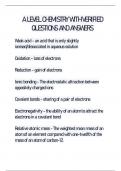
-
A LEVEL CHEMISTRY WITH VERIFIED QUESTIONS AND ANSWERS Weak acid - an acid that is only slightly ionised/dissociated in aqueous solution Oxidation - loss of electrons Reduction - gain of electrons Ionic bonding - The electrostatic attraction between op
- Exam (elaborations) • 9 pages • 2024
-
- £16.35
- + learn more
A LEVEL CHEMISTRY WITH VERIFIED QUESTIONS AND ANSWERS Weak acid - an acid that is only slightly ionised/dissociated in aqueous solution Oxidation - loss of electrons Reduction - gain of electrons Ionic bonding - The electrostatic attraction between oppositely charged ions Covalent bonds - sharing of a pair of electrons Electronegativity - the ability of an atom to attract the electrons in a covalent bond Relative atomic mass - The weighted mean mass of an atom of an element ...
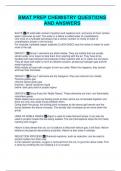
-
BMAT PREP CHEMISTRY QUESTIONS AND ANSWERS
- Exam (elaborations) • 8 pages • 2024
- Available in package deal
-
- £7.68
- + learn more
SALTS All solid salts consist of positive and negative ions, and some of them contain water molecules as well. The water in a lattice is called water of crystallisation. One mole of a hydrated salt always has a certain number of moles of water of crystallisation shown in the formula. For example, hydrated copper sulphate (CuSO4.5H2O) has five moles of water for each mole of the salt. GROUP 1 Group 1 elements are alkali metals. They are metals that are usually stored under oil or argon to s...

£5.50 for your revision notes multiplied by 100 fellow students... Do the math: that's a lot of money! Don't be a thief of your own wallet and start uploading yours now. Discover all about earning on Stuvia


